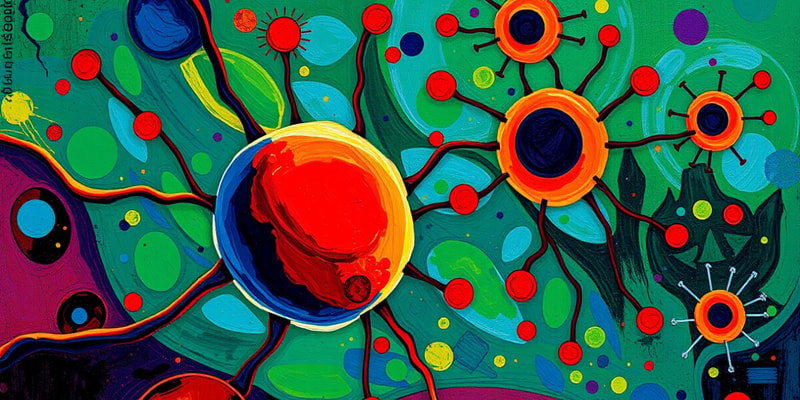Questions and Answers
Which statement best describes the role of negative feedback in cell signaling?
Which of the following is NOT a characteristic of G protein-coupled receptors (GPCRs)?
What distinguishes receptor tyrosine kinases (RTKs) from enzyme-linked receptors?
Which classification of signaling molecules primarily interacts with intracellular receptors?
Signup and view all the answers
Identify the correct sequence of events that occur in the PI3-K signaling pathway upon ligand binding to receptor tyrosine kinases (RTKs).
Signup and view all the answers
What is the primary function of positive feedback in signaling pathways?
Signup and view all the answers
Which of the following best describes the role of G protein-coupled receptors (GPCRs) in cell signaling?
Signup and view all the answers
What distinguishes membrane-bound receptors from intracellular receptors?
Signup and view all the answers
How are signaling molecules classified based on their properties?
Signup and view all the answers
What is a key characteristic of down-regulation in receptor signaling?
Signup and view all the answers
Which of the following components is not part of the cell signaling process?
Signup and view all the answers
In the context of signaling pathways, what role does the Cyclic-AMP-dependent Protein Kinase (PKA) play?
Signup and view all the answers
Which process describes a situation where a cell enhances its response to a signaling molecule after prior exposure?
Signup and view all the answers
Which of the following correctly depicts the basic function of G protein-coupled receptors (GPCRs)?
Signup and view all the answers
What characterizes endocrine signaling among the different types of cell signaling?
Signup and view all the answers
Which type of receptor is located within the cell and responds to lipophilic signaling molecules?
Signup and view all the answers
Which of the following statements accurately contrasts up-regulation and down-regulation of receptors?
Signup and view all the answers
What type of signaling allows a cell to affect itself as both a signaling and target cell?
Signup and view all the answers
Among the following options, which is NOT a component of cell signaling?
Signup and view all the answers
In which pathway do neurotransmitters play a critical role in signal transmission?
Signup and view all the answers
How can signaling molecules be classified based on their chemical properties?
Signup and view all the answers
Study Notes
Overview of Cell Signaling
- Cell signaling involves the transduction of messages between cells, leading to altered behaviors in target cells.
- Fundamental components include a signaling cell, an extracellular ligand, a target cell, and a receptor.
Types of Signaling
- Endocrine Signaling: Molecules travel through the bloodstream to distant target cells.
-
Paracrine Signaling: Molecules act on nearby cells. Includes:
- Juxtacrine: Direct contact between signaling and target cells.
- Synaptic: Signals transmitted through action potentials via neurotransmitters.
- Autocrine Signaling: The signaling cell also serves as the target cell.
Signaling Molecules
- Classify signaling molecules as:
- Lipophilic ligands: Fat-soluble, can pass through membranes.
- Peptide ligands: Water-soluble, bind to cell surface receptors.
Cell Surface Receptors
- Receptors can be membrane-bound or intracellular, differing in location, structure, and function.
- Major classes of cell-surface receptors:
- G protein-coupled receptors (GPCRs)
- Enzyme-linked receptors
- Ion-channel-linked receptors
Signaling Pathways
- G protein-coupled receptors, enzyme-linked receptors, and ligand-gated ion channels activate different downstream signaling pathways.
-
Receptor Tyrosine Kinase (RTK) pathway involves three major signaling pathways:
- PI3-K pathway
- Ras/MAPK pathway
- PLC pathway
- Activation of receptors can lead to protein activity changes or gene expression modifications.
Feedback Mechanisms
- Distinguish between:
- Negative feedback: Reduces signaling output.
- Positive feedback: Enhances signaling output.
- Understand receptor dynamics including activation, deactivation, up-regulation, down-regulation, sensitization, and desensitization.
Clinical Relevance
- Ability to understand signaling components allows for the assessment of clinical scenarios, such as insulin signaling in glucose regulation.
- For instance, the PI3-K pathway in insulin signaling leads to glucose transporter (GLUT4) translocation, crucial for glucose uptake.
Important Concepts
- A single signaling molecule can have multiple effects depending on the type of target cell and its expressed receptors.
- Recognition of how cells adjust their sensitivity to signals is important for understanding physiological responses.
- Phosphorylation of tyrosines on activated receptors provides docking sites for proteins with SH2 domains, facilitating signal transduction.
Receptor Types Overview
- Receptor types involved in signaling include:
- Receptor tyrosine kinases: Mediate growth factor signaling.
- Receptor serine/threonine kinases: Signaling in TGF-β pathways.
- Class I cytokine receptors: Act through a different mechanism than RTKs, relevant in immune responses.
These notes provide a structured overview of the principles of cell signaling and its significance in biology and medicine.
Studying That Suits You
Use AI to generate personalized quizzes and flashcards to suit your learning preferences.
Description
This quiz explores the fundamentals of cell signaling, including types of signaling and the roles of various signaling molecules. Learn about endocrine, paracrine, and autocrine signaling, as well as the characteristics of different receptors. Test your knowledge on how cells communicate and respond to signals.



